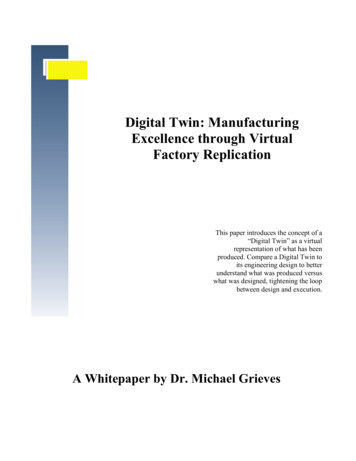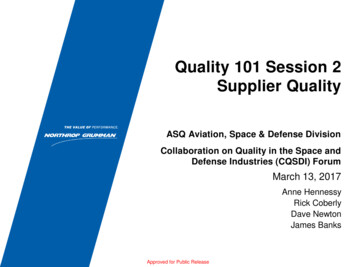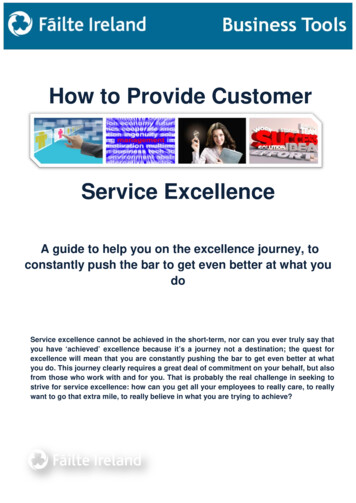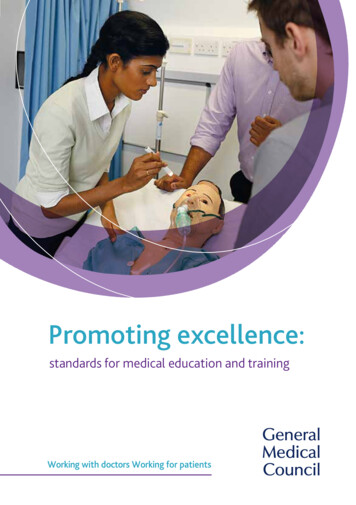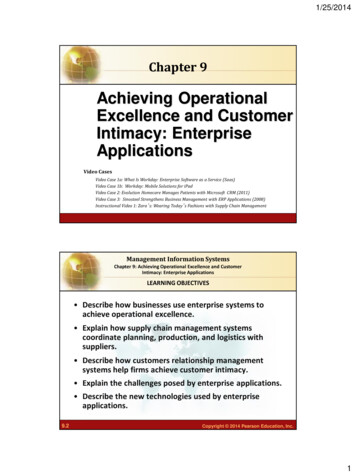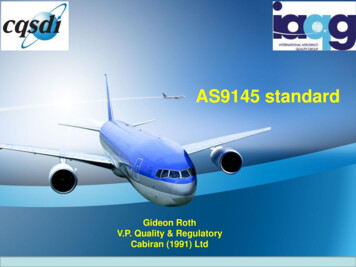
Transcription
AS9145 standardGideon RothV.P. Quality & RegulatoryCabiran (1991) Ltd
Background Advanced product quality planning (APQP) is aprocess developed in the late 1980s by acommission of experts gathered around 'Big Three' USautomobile industry: Ford, GM and Chrysler.The launch of the first APQP manualwas in June 1994. APQP is a structured method that deploysthe necessary quality plan that willassure that a product or a servicesatisfies the customer
Background In 1982 AIAG (Automotive Industry Action Group)developed Production Part Approval Process (PPAP) toaffirm product quality planning.The first manual on PPAP was published in February1993. PPAP is a method that verifies that the supplier’sproduction process has the capability toproduce parts at the rate and quantityspecified by the customer and that all thecustomer’s engineering design record andspecification requirements are properlyunderstood.
Background In Automotive industry both techniques are implementedand in use since the 80th of the 20th century In Aviation they are in use only in recent years. In 2016 a new standard – AS9145 Aerospace Series –Requirements for Advanced Product Quality Planning andProduction Part Approval Process was released The standard was developed by a team nominated byIAQG.
AS9145 team
Aerospace APQP Model
IntroductionFrom the standard:“This standard specifies requirements in astructured framework to plan and completeactions of the product realization cycle whichare necessary to ensure quality product(s)are delivered on time, while satisfying costperformance targets.”
IntroductionFrom the standard:“Successful implementation of APQPrequires: management commitment and support from thebeginning of the product development cycle, multidisciplinary project teams integrating allstakeholders and delivering a committedtimeline for executing planned activities.“
IntroductionFrom the standard:“APQP has five phases starting withconceptual product needs and extendingthroughout the product life cycle. The actualduration of each phase will differ dependingupon the scope and timing of the specificproduct and/or production developmentproject.”
The APQP phases:Alignment with Product Development Process (PDP)Kick offEnd of Productiondesign readinessEnd ofconceptProductvalidationProduct DevelopmentProcessAPQP phases1 - PlanningDA5 - Production4 - Product ProcessValidation2 - Product Design & Development BE3 - Process Design & DevelopmentCAPQP supports Product Development Process (PDP) Applies to each item of the product breakdown structure Standardizes deliverables for each Aerospace APQP Phase Evaluates maturity based on timing and quality of required deliverablesAPQP milestones
Cascade through Product BreakdownStructure (PBS)Kick off3 - Report APQPstatus at project level End ofdesignEnd ct DevelopmentProcessSystem level1 - Planning5 - Production4 - Product ProcessValidation2 - Product Design & Development3 - Process Design & DevelopmentSub-system level1 - Planning5 - Production4 - Product ProcessValidation2 - Product Design & Development3 - Process Design & DevelopmentComponents level1 - Planning5 - Production2 - Product Design & Development4 - Product ProcessValidation3 - Process Design & Development1 - Cascadedeliverables and aligntiming for each levelTypical PBS:system sub-system componentNote: Compressed timelineto support program timing2 - Bottom up status basedon on-time on-qualitydeliverables
APQP 5 Phases 1 – Planning: collect projectinputs and set the project. 2 - Product Design & Development: Design the productconsidering all identified requirements and risks 3 – Process Design & Development: Design themanufacturing and assembly process considering all identifiedrequirements and risks 4 – Products & Process Validation: Validate that the processis producing the specified product at the required rate 5 – Production: Reduce variation, manage any nonconformity, continuous improvement and feed lessons learnedback into the new product development projects
Phase 1 PlanningKick offEnd ofconceptEnd of Productiondesign readinessProductvalidationProduct DevelopmentProcessAPQP phases1 - Planning5 - Production4 - Product ProcessValidation2 - Product Design & Development3 - Process Design & DevelopmentAPQP milestones
Phase 1 Planning: Activities Collect the technical and non-technical requirementsapplicable to the product and associated project Develop a Statement of Work (SOW) for the project Define the product and associated project targets Develop the product breakdown structure [i.e., high-levelBill of Material (BOM)] to support source selection Coordinate and communicate timing with all applicablestakeholders Schedule all key dates and deliverables in the projectplan
Phase 1 Planning: Deliverables Product design requirements Project targets – safety, quality/manufacturability,service life, reliability, durability, maintainability,schedule, and cost Preliminary listing of Critical Items (CIs) and KeyCharacteristics (KCs) Preliminary BOM Preliminary process flow diagram SOW review Preliminary sourcing plan Project plan
Phase 1 Planning: Outputs The product concept is frozen (milestone A) and apre-design is available Concurrent product design and process design canstart
Phase 1 Planning: ChecklistsIn the IAQG/SCMH you will find the followingchecklists: 1.01 Project Inputs 1.02 Technical DesignRequirements 1.03 Reliability & Qualitygoals 1.04 Preliminary Listingsof Critical Items & KC 1.05 ProductSpecification 1.06 Preliminary BOM 1.07 Preliminary ProcessFlow Chart 1.08 Statement of WorkReview 1.09 Sub-tier Selection &Management 1.10 APQP Timeline
Phase 1 Planning: ChecklistexampleTable 1#123456789QuestionWas a a cross-functional team used to gatherproject inputs including the following as applicable:Program Management, Quality, Design Engineering,Manufacturing Engineering, Marketing and Sales,Procurement?Are applicable regulatory requirements available?Y*NN/ARYGEvidenceEvidenceAre customer requirements available including:Project milestones and product delivery dateProjected volumesProject lifecycleProduct and process assumptionsAre all internal data to build product performanceexpectations available including: Historical problems internal and external Warranty Reliability requirements Quality requirements Technical RequriementsHave lesson learned been conducted including: Best Practices Project management Quality issues Product design guidelines Process design guidelinesIs the company strategy available including: Business plan Marketing strategy Industrial strategy Technical strategyHave the resulting project/product requirementsbeen referenced/recorded into a repository,including supporting data?Data is made available to be used by the projectteam?Is there a process to keep formal requirementsdocument up-to-date?Has (Have) any potential risk(s) not highlighted byprevious question been identified? If no, describethis risks?MarkingQuestionsRating1011XIPStatus (%):25%N/ADeliverable RYG Rating50%25% - Action Identified75% - Action in Progress50% - Owner Identified100% - Action ClosedActions Required75%RRed: Some questions have a negative answer and no recovery plan is in place or the plansidentified will have an impact in program timing. Support is required. When an item ishighlighted Red an assessment on the impact to the WP timing needs to be provided.100%YGYellow: Some questions have a negative answer but a recovery plan is in place which willpreventimpacton timingGreen: Allquestionshave a positive answer (Y) and are ongoing normal program developmentThefollowingslidesshow theprinciple ofthe SCMHchecklists.Eachphase hasit’s ownchecklists
Phase 1 Planning: Checklistexample – questions sectionTable 1QuestionWas a a cross-functional team used to gatherproject inputs including the following as applicable:Program Management, Quality, Design Engineering,Manufacturing Engineering, Marketing and Sales,Procurement?Are applicable regulatory requirements available?Are customer requirements available including:Project milestones and product delivery dateProjected volumesProject lifecycleProduct and process assumptionsAre all internal data to build product performanceexpectations available including: Historical problems internal and external Warranty Reliability requirements Quality requirements Technical RequriementsHave lesson learned been conducted including: Best Practices Project management Quality issues Product design guidelines Process design guidelinesIs the company strategy available including: Business plan Marketing strategy Industrial strategy Technical strategyHave the resulting project/product requirementsbeen referenced/recorded into a repository,including supporting data?Data is made available to be used by the projectteam?Is there a process to keep formal requirementsdocument up-to-date?Has (Have) any potential risk(s) not highlighted byprevious question been identified? If no, describethis risks?Y*The questions are used to evaluate the quality ofthe deliverable attached to the element.Typical aspects of the deliverable to beevaluated through the questions are:1. Quality/availability of the inputs needed tobuild the deliverable2. Cross-functional approach to answer thedeliverables3. Quality /conformity to a standard if any or tobest practices4. control of the outcome of thedeliverable (e.g. action plan)
Phase 1 Planning: Checklistexample marking sectionY* - Put an "X" if complete and isOK or "IP" if in-progress as planned.N - Put an "X" if it is Not OK .N/A - Put an "X" if you have agreed with your customer that thisquestion is Not Applicable.RYG - Put an "R" here if the answer to the question is notacceptable and there is no recovery plan. Put a "Y" here if thereare problems with the question but is recoverable with an actionplan in place. Put a "G" if it is on track or satisfactorilycomplete.Y*NN/A RYGWhen you put an "R" or "Y" you willneed to complete the "Actions Required" andsubsequent columns.
Phase 1 Planning: Checklistexample evidence & ratingTable 1Input evidence of the answer to the question (e.g.:document reference) here. If an "X" is in the preceding Ncolumn then describe the issue here including root cause inorder to identify proper actions .Status (%):25% - Action Identified75% - Action in Progress50% - Owner Identified100% - Action Closed75%100%RRed: Some questions have a negative answer and no recovery plan is in place or the plansidentified will have an impact in program timing. Support is required. When an item ishighlighted Red an assessment on the impact to the WP timing needs to be provided.YGYellow: Some questions have a negative answer but a recovery plan is in place which willpreventimpacton timingGreen: Allquestionshave a positive answer (Y) and are ongoing normal program development
Phase 1 Planning: Checklistexample table 2Actions RequiredResponsibleOpenDateDueDateStatus Actual EndDate%For each questions in table 1 you specify theactions, responsibilities and dates in table 2
Phase 2 Product Design andDevelopmentKick offEnd ofconceptEnd of Productiondesign readinessProductvalidationProduct DevelopmentProcessAPQP phases1 - Planning5 - Production4 - Product ProcessValidation2 - Product Design & Development3 - Process Design & DevelopmentAPQP milestones
Phase 2 Product Design andDevelopment The purpose of this phase is to ensure designfeatures and characteristics are formalized and ready forprocess design and development. During this process the intended production phases andpotential supplier used to realize the product are identified. During this phase the organization shall identify &review theproduction process design input requirements, including:– Product design records.– Targets for productivity, process capability, quality, and cost.– Customers and regulatory requirements, including customer demandrate.– Lessons learned.
Phase 2 Product Design andDevelopment: ActivitiesThe phase includes the following: Turning product specifications into robust product definition––––– Design risk analysisDesign for Manufacture and Assembly (DFMA)Design for Maintenance, Repair, and Overhaul (DFMRO)Identification of product KCsProduct error proofingCreate BOMConduct design reviewsValidate and verify product designConduct design record review at productionsources to evaluate manufacturing feasibility
Phase 2 Product Design andDevelopment: Deliverables General note – in the next phases an * means that this is anelement of the PPAP file and may be required for the PPAPsubmission
Phase 2 Product Design andDevelopment: Deliverables Design risk analysis* Design records and BOM* addressing the findings of the designrisk analysis DFMA, tolerance, stack-up analysis, etc. Special requirements, including product KCs and CIs listings Preliminary risk analysis of sourcing plan Packaging specification Design review report Development product build plan Design verification & validation plans, and associated results Feasibility assessment
Phase 2 Product Design andDevelopment: Outputs Design record and BOM Design verification and validation plans, and associatedresults Specified prototype testing (e.g. simulation & functionaltesting) have been completed The product design is verified and validated (milestone B)by the design organizationAny design changes after this phase requires change management
Phase 2 Planning: ChecklistsIn the SCMH you will find the following checklists 2.01 DFMEA 2.02.1 Design forManufacturing &Assembly 2.02.2 Design for MRO 2.02.3 Product criticalitems & KC 2.02.4 New productpackaging specification 2.03 Design Reviews 2.04.1 DevelopmentProduct / Part Build Plan 2.04.2 Verification &Validation Testing 2.05 Design RecordReview by the ProductionSource 2.06 M
Advanced product quality planning (APQP) is a process developed in the late 1980s by a commission of experts gathered around 'Big Three' US automobile industry: Ford, GM and Chrysler. The launch of the first APQP manual was in June 1994. APQP is a structured method that deploys the necessary quality plan that will assure that a product or a service satisfies the customer . Background .
